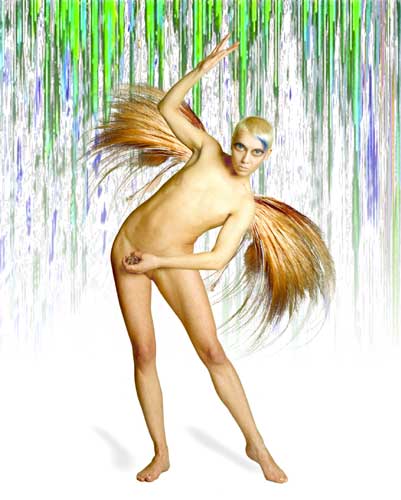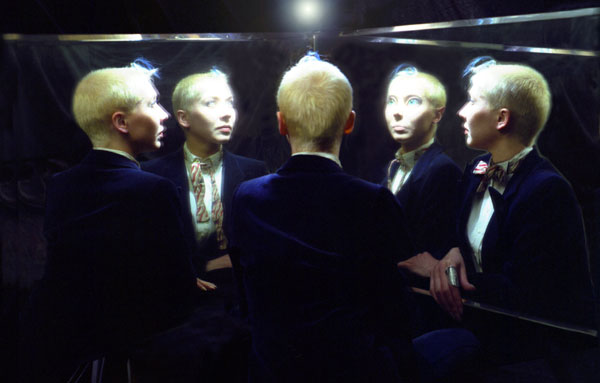


Those who make it impossible for unity to develop are the makers of angels.
James JoyceThe iconographic motif of a multiple portrait appeared and was often taken up by artists in the first decades of the 20th century (for example by W. Szpakowski, 1912, by Witkacy, 1917, and by Marcel Duchamp, 1917). The concept of that kind of portrait work was the direct result of the cubist breakthrough which sanctioned the presence of many points of view, placed the object analyzed in a context and released its meaning in this way.
The philosophical sanction for the portrait was supplied by phenomenology which - through Kant - became the direct legacy of the concept of the Carthesian cogito. Phenomenology proposed transcendental subjectivity a priori and enclosed the world within the perspective of intentional cognition. Many artists took up this kind of portrait for purely aesthetic reasons but for most of them it became an important part of their individual existential experience. The multiple portrait as a model of an internal relation (the man and his epiphenomena, facing only himself in an intimate space), during which the identity of the subject was being negotiated, helped to picture two different observations. On the one hand it visualised the impossibility of the cognition of "the one truth" about ourselves - if it exists at all. On the other hand it showed man's personality as a bunch of different selves and justified this vision as the closest to the truth.
Undertaking the iconographic motif of a multiple portrait as a figure of the continually repeated question of identity, Barbara Konopka denied any value of such a kind of cognitive relation (directed internally), which she deemed too autistic. Thanks to the redundance of the modified version of the portrait the artist shows its mechanism as a stuffy space for the production of a split personality - as the slit between the cognitive subject and its object (which are supposed to be identical in this case) where the "I" is wrought.
"[...] Even when the other is only me, me playing the part of another "me" in a double role: of the sender and of the receiver. Between those two roles, between me and the others (even if I am "them" myself), a split appears which makes any completeness of identity quite impossible."* The abovementioned split becomes the internal space for the ever repeated attempts at constructing the identity of the subject. The real world becomes only an element of the internal psychomachia within this space. The solipsistic relation is the reason why man as a being for himself is not able any more to enter the optimal interpersonal relations. The on-going privatization of society and the separation of man from other people lead him to create his internal space of the superego, where he feels an exile. "[...] Those people in the restaurant car thrived on the idea that each of them was an island that ought to be respected and that one does not enter into relations with one's neighbours with impunity. That is why they said nothing to one another. But in spite of that their silence contained many fearful, funny and exalted conversations - which were internalized. Our imagination contains numerous real and imaginary creatures which we create and recreate, form and transform without end. We do not talk with the other any more - we conduct a dialogue with the other within us."**
When Barbara Konopka exorcises the I in a multiple portrait she gives up the prerogatives of the subject lost in the nuances of its own interior in order to introduce the figure of a binary man in her series of digital photograms called "Illuminations. On-line.". The binary man becomes the material used to form virtual subjetivities in their relation with the exterior, with the other, not with the I-dentical. Konopka presents the binary man as a double being, empirical and transcendental, made up of two bodies - the physical and the media body. The physical body shown within the pluralism of the elements of its non-semantic speech, without channeling the meanings, loses its untouchability as "God's creation", the carrier of universal laws, and may be freely transformed (interference in genetic information, plastic surgery, sex change operations). The media body came into being thanks to the dispersion of digital technologies of carrying and processing information, as the extension and intensification of man's communicative and perceptive abilities, creating space for the continual interphase with the exterior.
The binary man as a set of analitically atomized physical and mental elements forms the potential for the constitution of subjectivity. It is the frame in whose space osmoses and interphases take place and where ephemeral identities crystallize as the result of contacting any given other. Similarly, as in the case of Barbara Konopka's multiple portrait in the series of digital photograms Illuminations. On-line., she makes use of well-known iconographic motifs in order to get her own message across. The presentation of the Vitruvian man, as an ideal of European humanism, sanctioned the homogenous construction of man and the world, the absolute truth, contained within every human being. The binary man breaks the Vitruvian model, creating its own space of relations with the world, each time different ones, setting the horizon for the existence of the rhizome, the play of difference and repetition (the artist inscribes herself in this way into the perspective of the philosophy of anti-humanism).
The second icon is a kind of a pastiche of a well-known image which announces the presence of mankind in outer space. B.K. shown as an empirical and transcendental double (the physical body and the mental epiphenomenon) symbolically annexes space and lays down the borders of the territory in which the creation and processing of information takes place (the mediatization of its ephemeral subjectivities). Constant movement, nomadic dismemberment and the location in space makes the binary man a phenomenon which constantly improves and broadens its communicative potential. The possibility of permanent transgression and personality transformation denies thinking in terms of identity-as-foundation. The emanation of this presentation in the space of the gallery situates the audience within the net of interactive relations. The curious absence of the work (the media and the physical body broken down into elements and reduced to the imaginary field of interphase) - osmosis, contact - is a proposition that the work be constituted as the annexation of new dimensions and connections.
The author evokes two spaces where identity is structuralized. Internal space in the multiple portrait and external space in Illuminations. Thus she closes the horizon of human experience. Similarly, the Deleusian perspective points to the model of osmotic dependence between two types of man's consciousness, represented on the one hand by the rhizome and on the other by a tree/root. The centric model, directed inside (a tree/root) introduces the principle of identity as the place occupied by a god or man. The model of the rhizome constitutes the type of existence as continual coming into being which is by definition a plurality, an irreducible multiplicity.
"[...] The rhizome is not one which can be dychotomically divided, One as a subject, an image or a world, and it is not the diverse which is the consequence of the One. Multiplicity is devoid of an object and a subject, it only possesses determinations and dimensions (i. e. the lines of segmentation and stratification), there is no unit of measure here, or numbers as the principle of order among elements, the multiplicities are defined by the exterior, by the lines of outflow or de-territorialization which add a different dimension to the given one."*** .£ukasz Ronduda
*M.P. Markowski, "Efekt inskrypcji. Jacques Derrida", p. 326
**Tadeusz Komendant, "W³adze dyskursu" ("The Powers of Discourse), Warsaw 1994
***Bogdan Banasiak, "Ogród koczownika. Deleuze - rizomatyka i nomadologia" ("The Garden of a Nomad. Deleuze - Rhizomatics and Nomadology"), "Colloquia Communia", 1988, vol. 1-3 .


Copyright ©2000 Barbara Konopka, £ukasz Ronduda, Galeria FF £DK